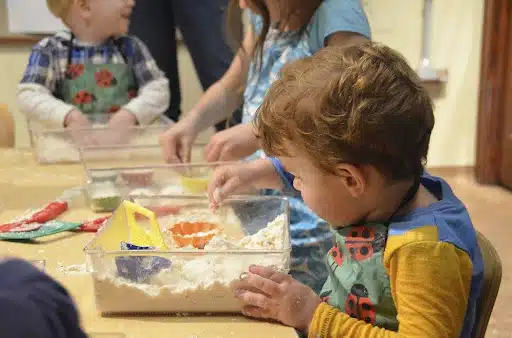10 Fun Sensory Play Activities to Support Your Child’s Therapy Progress
Sensory play can be easily incorporated at home with simple activities like finger painting or playdough. These hands-on exercises make therapy more approachable, allowing your child to practice important skills outside of formal sessions.
- What is sensory play, and why is it important for child development?
Sensory play involves activities that engage a child’s senses (touch, sight, sound, etc.), promoting exploration and creativity. It is essential for child development as it helps improve motor skills, enhances sensory processing, and supports cognitive growth. Sensory play is also beneficial for emotional regulation, allowing children to better understand and manage sensory inputs. These activities are particularly helpful in therapy, fostering skills that contribute to overall progress and development.
- Can sensory play improve my child’s motor skills?
Yes! Activities like water play and obstacle courses are great for improving both fine and gross motor skills, strengthening muscles, coordination, and balance in a fun, engaging way.
- How can I make sensory play a part of our daily routine?
——–
Supporting your child’s therapy through sensory play doesn’t just build skills—it brings the family together. At Uplift Therapy Center, we’ve seen firsthand how engaging sensory play can foster both developmental progress and emotional connection. Our mission centers on empowering families with tools to help children thrive, not just in therapy but at home, school, and within the community.
Let’s dive into some enjoyable, simple activities that can help your child reach their therapy goals while creating fun memories.
1. Sensory Bins
A sensory bin is a wonderful way to engage your child’s sense of touch and imagination. Fill a bin with rice, beans, or pasta, and add small toys or objects for your child to discover. It’s easy to customize based on your child’s preferences or therapy goals.
What You Need to Create a Sensory Bin:
A large plastic bin, filler materials like rice, beans, or pasta, small toys, spoons, or cups for scooping.
How To Create The Sensory Bin:
- Fill a bin with your chosen material.
- Hide toys or objects in the bin for your child to find.
- Let your child scoop, pour, and dig for a full tactile experience.
Why It Helps:
This hands-on activity supports fine motor development and sensory processing. It also provides a safe space for exploration, helping children become more comfortable with different textures and sensations, which is crucial for growth.
2. Water Play
Turn bath time into an opportunity for therapy! Fill a tub with warm water, add some bubbles, and let your child explore with cups, sponges, and floating toys. For a fun twist, you can add food coloring or a small amount of dish soap to make it extra engaging.
What You Need For Water Play:
A shallow tub, water, cups, sponges, floating toys, optional food coloring or bubbles.
How To Do It:
- Fill a tub with warm water and add toys or cups.
- Let your child splash, pour, and explore the water.
- Add bubbles or color for extra fun.
Why It Helps:
Water play offers both calming and stimulating effects. It promotes motor control and builds strength in the hands and fingers, which is especially helpful for children working on fine motor skills. Plus, the sensory feedback water provides helps kids relax—a benefit that can extend into therapy sessions.
3. Playdough Fun
Grab some playdough and let your child’s creativity run wild. They can roll, squish, or cut shapes with cookie cutters. You can even make your own dough at home with simple ingredients like flour, water, and salt.
What You Need for Playdough Fun:
Playdough (store-bought or homemade), cookie cutters, rolling pins, textured stamps.
How To Do It:
- Encourage your child to roll, squish, and mold the dough.
- Use cookie cutters to make shapes or create simple figures.
- Discuss the textures and colors they experience as they play.
Why It Helps:
Manipulating playdough is excellent for strengthening those tiny hand muscles. For kids working on handwriting or using utensils, this can be a game-changer. Playdough also has a soothing quality, perfect for children who might feel overwhelmed by more structured therapy.
4. DIY Obstacle Course
Turn your living room or backyard into a mini obstacle course. Use pillows, chairs, and tunnels to create different challenges. Crawling under tables, balancing on cushions, or jumping over stuffed animals are just a few ideas to get started.
What You Need For an Obstacle Course:
Pillows, chairs, tunnels, hula hoops, boxes, or any household objects.
How To Do It:
- Set up a course with different stations for jumping, crawling, and balancing.
- Guide your child through each part of the course.
- Adjust difficulty based on your child’s needs.
Why It Helps:
Obstacle courses help improve balance, coordination, and overall body awareness. They also encourage problem-solving and following multi-step directions—skills that are often part of therapy goals. Plus, it’s an activity where the whole family can join in and have fun!
5. Finger Painting
Set up a painting station with non-toxic paints, brushes, and paper. Let your child experiment with their fingers, hands, or even feet! If you’re worried about the mess, finger painting can be done outside or on a covered surface.
What You Need For Finger Paint Fun:
Non-toxic finger paints, large sheets of paper, optional brushes or sponges.
How To Do It:
- Set up a designated area for mess-free painting.
- Let your child use their fingers or hands to paint freely.
- Encourage them to describe how the paint feels and the colors they are using.
Why It Helps:
Finger painting taps into a child’s creativity while offering sensory feedback through touch. It also helps refine hand-eye coordination and fine motor control—important areas in many therapy plans. For kids who are sensitive to textures, this playful activity can gently introduce them to new sensations.
6. Sensory Bottles
Create sensory bottles by filling a clear plastic bottle with water, glitter, and small toys. Seal it tight, and you’ve got a calming, visual experience that your child can explore by shaking or rolling the bottle.
What You Need for Sensory Bottles:
Clear plastic bottles, water, glitter, small beads, food coloring (optional).
How To Do It:
- Fill a bottle with water and add glitter or beads.
- Seal the bottle tightly.
- Let your child shake or roll the bottle, watching the objects inside move slowly.
Why It Helps:
These bottles provide visual stimulation that helps with focus and self-regulation. They’re great for moments when your child needs a break or to calm down. The slow movements of glitter or objects inside encourage mindfulness and can support attention-building exercises.
7. Bubble Wrap Jumping
Who doesn’t love the satisfying pop of bubble wrap? Lay down a sheet of it and let your child stomp or roll on it. You can even turn it into a game where they have to pop specific bubbles!
What You Need:
A large sheet of bubble wrap.
How To Do It:
- Spread the bubble wrap on the floor.
- Encourage your child to stomp, jump, or roll across the bubble wrap.
- Celebrate each “pop” to make the activity even more fun.
Why It Helps:
This activity provides proprioceptive input, which helps children better understand their body’s position in space. It’s also fantastic for improving balance and coordination. The immediate feedback from the popping sounds adds a sensory element that keeps the activity engaging.
8. Texture Exploration Bags
Fill ziplock bags with various textures like rice, beans, or even slime. Let your child explore by squeezing or pressing the bags. You can label each bag with different textures and let them guess what’s inside.
What You Need For Texture Bags:
Ziplock bags, filler materials like rice, beans, slime, or hair gel, tape to seal bags.
How To Do It:
- Fill each bag with a different texture, then seal tightly with tape.
- Let your child squish and squeeze the bags to explore how each texture feels.
- Ask them to guess what might be inside based on the sensation.
Why It Helps:
Exploring different textures in a controlled environment helps children process sensory input without feeling overwhelmed. This is especially useful for kids with tactile sensitivities, as it allows them to interact with new sensations at their own pace, building tolerance over time.
9. Dance Party
Put on your child’s favorite songs and have a dance party! Encourage different types of movement, like jumping, spinning, or clapping to the beat. If you have simple instruments like a tambourine or shaker, let your child create their own music.
What You Need for a Dance Party:
Music player or speaker, optional instruments like maracas or tambourines.
How To Do It:
- Play upbeat music and encourage your child to dance however they like.
- Add simple instructions like “clap your hands” or “jump to the beat” to enhance the activity.
- Play along with toy instruments for added fun.
Why It Helps:
Music and movement encourage whole-body coordination, motor planning, and rhythm. Dancing to music helps develop balance, timing, and spatial awareness—skills that are often emphasized in therapy. Plus, it’s an activity that can lift everyone’s mood!
10. Therapy Ball Play
If you have a large therapy ball at home, let your child sit, bounce, or roll on it. You can also play simple games, like having them roll the ball back and forth with you.
What You Need For Ball Play:
A large therapy ball (size appropriate for your child).
How To Do It:
- Let your child sit, bounce, or roll on the ball while you provide light support.
- You can also roll the ball back and forth for a fun game.
- Try simple balancing exercises by having your child sit and reach while staying steady.
Why It Helps:
Therapy balls help strengthen core muscles, improve balance, and promote body awareness. The rhythmic bouncing or rolling can also be very soothing, making it a great activity for children who need help regulating their energy or emotions.
How Sensory Play Supports Your Child’s Therapy Journey
These fun activities aren’t just a way to pass the time—they’re part of the bigger picture when it comes to your child’s development. At Uplift Therapy Center, we encourage families to integrate these playful exercises into daily routines because they reinforce the skills children are working on in therapy.
Sensory play taps into a child’s natural curiosity and joy. It helps them explore their world and build essential skills, like motor control, attention, and self-regulation. More importantly, it fosters a stronger connection between you and your child, making therapy a more collaborative process.
Incorporating sensory activities at home bridges the gap between therapy sessions and everyday life. Whether you’re working on improving your child’s motor skills, speech, or emotional regulation, these activities can give your child a little extra boost while having fun.
Creating Meaningful Moments Through Play
Supporting your child’s therapy with sensory play is one of the most impactful ways to help them succeed. It creates moments of joy and growth, strengthening their skills while keeping the process light and engaging. Every child is unique, and sensory play provides endless ways to cater to their individual needs, whether it’s calming down after a busy day or practicing new movements.
Remember, your child’s progress isn’t limited to the clinic—it happens at home, in the community, and in every playful moment you share. So roll up your sleeves, grab some sensory-friendly materials, and dive into these activities. The benefits go far beyond play; they are building blocks for a brighter, stronger future for your child.
Links and Resources for more reading:
- “Sensory Play Ideas for Toddlers and Preschoolers” – https://www.pathways.org/sensory-play-activities-for-kids/
- “Occupational Therapy and Sensory Play” – https://www.aota.org/practice/children-youth/understanding-sensory-processing-disorders




